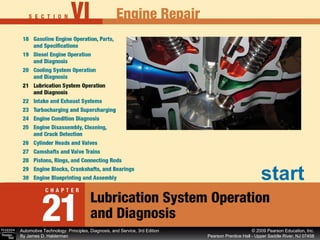Engine Oil Guide for ASE Certification Test
•Download as PPT, PDF•
0 likes•660 views
The document discusses engine lubrication systems and oil pumps. It explains how oil pumps work to circulate engine oil through lubrication passages to components like main bearings, cam bearings, and valve train parts. It describes the factors that influence oil pressure, like oil viscosity and pump capacity. It also covers checking oil pumps for wear and setting maximum pressure with relief valves.
Report
Share
Report
Share

More Related Content
What's hot
What's hot (20)
Viewers also liked
Viewers also liked (8)
Similar to Engine Oil Guide for ASE Certification Test
Similar to Engine Oil Guide for ASE Certification Test (20)
MEC258A-IC Engines-Lubrication System in IC Engine.pptx

MEC258A-IC Engines-Lubrication System in IC Engine.pptx
More from mcfalltj
More from mcfalltj (20)
Engine Oil Guide for ASE Certification Test
- 1. start
- 19. Figure 21–10 A typical engine design that uses both pressure and splash lubrication. Oil travels under pressure through the galleries (passages) to reach the top of the engine. Other parts are lubricated as the oil flows back down into the oil pan or is splashed onto parts.
- 23. Figure 21–11 (a) A visual inspection indicated that this pump cover was worn. (b) An embedded particle of something was found on one of the gears, making this pump worthless except for scrap metal.
- 24. NOTE: The oil pump is the “garbage pit” of the entire engine. Any and all debris is often forced through the gears and housing of an oil pump. Figure 21–12 (a) The oil pump is the only part in an engine that gets unfiltered engine oil. The oil is drawn up from the bottom of the oil pan and is pressurized before flowing to the oil filter. Figure 21–12 (b) If debris gets into an oil pump, the drive or distributor shaft can twist and/or break. When this occurs, the engine will lose all oil pressure.
- 36. Therefore, oil consumption is based on the amount of work an engine per forms. Although the formula may not be usable for vehicle engines used for daily transportation, it may be usable by the marine or industrial engine builder. Generally, oil consumption that is greater than 1 quart for every 600 miles (1,000 kilometers per liter) is considered to be excessive with a motor vehicle. What is Acceptable Oil Consumption? - Part 2
- 38. end